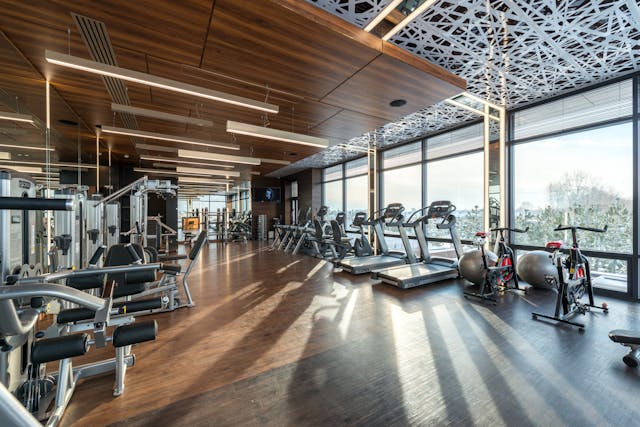The bustling gym, an iconic beacon of health and fitness, poses not only a question of personal agency for adults but also, inadvertently, kindles a discussion surrounding the age at which minors are fit to enter. In recent years, with the spotlight on childhood obesity and the rising trend of child fitness enthusiasts, it’s more than a personal inquiry; it’s a query that pertains to the community at large, especially parents eager to encourage healthy habits. But how old is old enough to sweat it out in this adult realm?
The Rationale of Gym Age Restrictions
The gym is a space where ambition meets exertion—where the formidable hurdles of health goals are either confronted or avoided. Gym owners, understanding this dynamic, impose age restrictions not out of capriciousness but out of a diligent concern for safety and legal liability. The rationale is clear: weights and machines, while virtues for one body, can turn into vices for another, less experienced one.
Young bodies are still in the developmental stage, where bones, tendons, and ligaments may not be fully formed to withstand the rigors of heavy exercise or pressure lifting. Injuries in young athletes are more pronounced and considerably fragile, even if they appear otherwise. Therefore, regulations set to ensure that gym-goers have reached a stage of physical maturity are the first steps in mitigating these risks.
The Legal Gym Landscape
The age at which children can attend the gym is a mixed bag legally. In the United States, for example, it is not uncommon for children as young as 12 to have full access, while in other countries, there are stricter age barriers, sometimes requiring individuals to be 16 or 18 before they can step onto the gym floor. The divergence in these legal standings reflects various cultural and legal considerations.
Notably, local authorities or gym chains often set these age limits. They are crafted after considerable thought, sometimes with the input of medical professionals to ensure the best interests of children, and avoid accidents and potential lawsuits. However, once the legal threshold is crossed, the benefits of exercise significantly outweigh the risks, and the gym presents an excellent opportunity for young people to enjoy the advantages of a healthy lifestyle.
Wrestling with Ethics and Responsibility
The issue of children in the gym is more than a legal one; it’s a matter of ethical responsibility. Professionals within the fitness industry, including personal trainers and gym staff, must weigh the desire to encourage fitness in the young against the potential risks associated with premature or unsupervised training.
Parental guidance, in this context, is indispensable. The gym experience for a minor should not be one where they are left to their own devices, but rather a stepping stone that embodies an informed, mutual instructional process of exercise, nutrition, and general physical health. Encouragement and example-setting from parents can lead to independent, disciplined exercise regimens—be it in the gym, or in safer, more age-appropriate settings such as youth sports or home workouts.
Initiatives to Nurture Healthy Junior Gym-Goers
The growing understanding of the importance of physical activity for children has paved the way for numerous initiatives aimed at fostering their involvement in healthy practices. Some gyms offer specific programs or classes for youths, often led by trained professionals who understand the balance between toughening training and cautious conditioning.
These programs, while physically beneficial, also cultivate a healthy mindset towards personal health, dispelling the notion that physical fitness is solely an adult concern. They lay the groundwork for lifelong fitness habits and can be the catalyst for self-assured, health-conscious individuals entering adulthood.
Unlocking Fitness: Navigating Gym Age Policies

- Start Early, Sweat Smart:
- Age 12–16 is the sweet spot for gym entry. However, this threshold dances to its own tune across locations. State laws and gym regulations choreograph this delicate ballet, so tread lightly.
- Parental Permission: Before donning those workout sneakers, kids need a parental nod. It’s like a backstage pass to the fitness concert.
- Supervision Alert: Some gyms play chaperone—children under 18 might need a watchful eye while flexing those biceps.
- YMCA: Where Family Meets Fitness:
- The YMCA is the family-friendly haven for budding gym enthusiasts.
- Age 7 (with supervision): Your little one can groove alongside you in the fitness center.
- Age 10 (solo): After a fitness orientation, they can solo-jam on the equipment.
- 24-Hour Fitness: The Tween Zone:
- Age 12: The magic number here. With parental consent, tweens can join the fitness fiesta.
- No Under-12s: Sorry, kiddos, the treadmill isn’t your playground. But fear not—Kids’ Club babysitting awaits!
- Life Time Fitness: The Age of Independence:
- Age 12 (sans supervision): Life Time Fitness opens its doors wide. Equipment, classes, and amenities—all yours!
- Membership Key: As long as you’re part of the club, the gym’s your oyster.
- Safety First, Gains Second:
- Individual Health Matters: Age isn’t the sole compass. Health status and growth patterns steer the ship.
- Pre-Teens and Weights: Under strict supervision, pre-teens can dabble in weight training. Safety harness engaged!
Conclusion: Weights of Experience and Years
When it comes to kids and the gym, the conundrum of age is truly about determining readiness. It’s not a binary answer but one that lies on a spectrum of physical preparedness and mental maturity, a delicate tapestry of legalities and ethical considerations. The gym, a haven for the pursuit of endurance and strength, must align with the needs and vulnerabilities of our younger generation.
Conversations about the age requirement at the gym should, therefore, not only revolve around when one can legally step through those doors, but also how and under what circumstances. It’s a shared responsibility, one that involves parents, the fitness industry, and, when old enough, the aspiring gym enthusiast.
The answer, then, may lie in the creation and support of dedicated youth fitness programs, early education on the merits of fitness, and a slow integration into the gym environment under watchful eyes. In the collective effort to nurture responsible and healthy individuals, kids will eventually pick up their fair share of weights, not just at the gym, but in life.

